I’ve been a fan of Greg Rucka’s writing since his first comic, Whiteout. He was a novelist before that, but I came to his novels after his comics. I loved them, too. He’s done a lot of work for DC, and some for Marvel, but what I love the best are his creator-owned comics. Right now, he’s got two series ongoing: Black Magick, a supernatural thriller about a cop who is also a witch, and Lazarus, a series set in the near future where a handful of ultra-rich families own and control the entire world, with the rest of the world entirely subservient to them. (My joke is that I like Lazarus just fine, but I prefer reading fiction.) Truth is, both those series are fantastic. But I think my favorite Greg Rucka comic may be his Portland-set private eye series Stumptown.
Dex (short for Dexadrine—naming her that is one of many things for which Dex holds her parents responsible) Parios lives and works in Portland, where she also takes care of her brother, Ansel. Ansel is an adult, and has Down’s Syndrome. Dex works as a private investigator, and over the course of the series, we see her tackle four big cases and one small one, told in four graphic novels.
Before Rucka became a published novelist, he actually worked on an academic study of private eye fiction, and it shows. In so many ways, Dex completely fulfills the role of archetypical PI. She is a somewhat down on her heels, flawed character, much more adept at solving other people’s problems than her own. She is able to move across and interact with all levels of society. And she has a love/hate relationship with the police, which allows her to tap into their resources when she needs to, prevents her from doing so all the time, and allows her to go places they can’t.
Rucka hasn’t been shy about discussing Stumptown’s influences. He even cites books like Stuart Kaminsky’s Toby Peters series and TV shows like Rockford Files, Magnum PI (the original), and Simon & Simon as sources of inspiration. However, what makes Stumptown great is that while all those elements are present in its DNA, it’s very much its own thing. It’s an easy thing to do, honor something you love by creating new stories, like showing you love Magnum PI by creating a new Magnum PI series (as much as I love the new Magnum). It’s another thing to be inspired by something and use that inspiration to create something new. Something that prompts the same feelings as the original influence, but without imitating it.
The various cases Dex gets involved with reflect the series’ own spin as well. The first book focuses on a missing persons case, with some twists and turns along the way. While that basic premise doesn’t sound too far and away from other detective fiction, it allows Rucka to introduce Dex, her supporting cast, and her world.
In addition to Ansel, that cast and world include Tracy Hoffman, a Portland cop originally introduced in Rucka’s novel A Fistful of Rain, and Grey, Dex’s next door neighbor who takes care of Ansel when Dex is on a case. And, of course, the city of Portland is a character as well. Not only does the city provide distinct locations for the action, but as the series goes on, the cases become more and more unique to that particular city.
In addition to Tracy, another character from A Fistful of Rain returns in the second book. Musician Mim Braca, the main character of that novel, comes to Dex because someone has stolen her guitar. Right off the bat, it’s a different sort of kidnapping case, and things only get twister as they go.
I’m never quite sure where to start talking about the artists when I discuss comics. I usually talk about the story first, because that’s what I come to comics for. Otherwise, I would just be looking at art galleries. But the art is an intrinsic part of that storytelling, and while so many comics are written by one person and drawn by another, I give them equal weight in my mind. Having a compelling story and script is important, but the comic will only hook me if the story is told well through the art.
The first two Stumptown collections are illustrated by Matthew Southworth, who is fantastic. His art possesses a very grounded quality appropriate to a story so firmly planted in a real location. His storytelling is clear, which is especially impressive in action sequences like the car chases. And his character designs are fantastic, particularly Dex, who he draws as a realistically beautiful woman, not a supermodel. He uses a lot of light and shadow in his work, giving the series an increasingly noir feel.
Artist Justin Greenwood takes over for the third and fourth stories. Interestingly, while his style is pretty different from Southworth’s, it is equally appropriate for the series. Perhaps the biggest difference is that there is less of a sense of contrast, as things are more brightly lit and less shadowy (although there are still plenty of shadows). Also, Greenwood’s people are maybe a bit more stylistically drawn than Southworth’s. They still feel like people, and the later books still feel of a piece with the first two. Perhaps most importantly, Dex still feels like Dex and Portland feels like Portland.
The third book is maybe the closest the comic comes to being a murder mystery. (Maybe an attempted murder mystery?) Rucka and Greenwood place this tale against the background of local soccer fandom, which, once again, makes it feel very unique to Portland. I don’t know anything about the world of professional soccer and its fans, but this story makes it completely accessible and understandable to me.
Equally foreign to me, and equally unique to Portland, is the world of gourmet coffee. I just drink whatever my wife makes for me, and often have trouble telling the difference between the flavors she buys. It seems that Dex is is pretty much the same place when she is hired to protect a shipment of kopi luwak coffee for a billionaire coffee maker.
For those not in the know, kopi luwak is coffee made from coffee cherries partially digested by civets and recovered from their poop. It is extremely valuable, and Dex finds herself caught between another coffee gourmet billionaire and Barista Mafia, much to her frustration and bemusement. It is perhaps the most Portland of Portland private eye stories, and the last big Stumptown mystery to date.
However, it’s not the last Stumptown comics story; the fourth book ends with one shorter case, detailing Dex’s investigation of a possibly unfaithful wife. The story is mostly silent, and beautifully told through Greenwood’s art. This final short story, with the twist in its resolution, perfectly encapsulates the series in one short twenty-something page installment.
The final two books also deepen Dex’s personal life, brining in a romantic interest and more information about her family. I don’t want to spoil anything, but these complications really flesh out Dex as a character, and broaden and deepen the series as a whole.
While there are only the four Stumptown collections to date, I hold out hope that Rucka will eventually return to the series. In the meantime, this isn’t quite the last we’re going to see of Dex Parios and Stumptown: we will be getting a Stumptown TV series on ABC this fall. I don’t know anything about it beyond the trailer that has been released, except that it pretty much looks like the comic brought to life on the screen. (Maybe with the addition of a male cop love interest, because Hollywood.)
I am definitely excited to see the show. I hope it’s as faithful to the tone of the comic as the trailer makes it look. And I hope that means more comics issues in the future.
When I started thinking about writing this post, I was thinking that besides Stumptown, the only other really good female private eye comic I could remember was Max Allan Collins and Terry Beatty’s Ms Tree. Of course, I immediately started thinking of other titles, like Mike W. Barr’s Maze Agency, Brian Michael Bendis’s Jinx and Jessica Jones, Hope Larson and Brittany Williams’s Goldie Vance, and Chuck and Lisa Moore’s Dominique. I’m sure I’m forgetting some. Still, it’s not a huge list, and I don’t know that any of them are being published any more. So I really hope we haven’t seen the end of Stumptown as a comic.
This week’s 2000 AD highlights include not only the regular comic from the last two weeks, but also this summer’s 2000 AD Sci-Fi Special. The special is somewhat bittersweet, being a tribute to the late Carlos Ezquerra, longtime 2000 AD artist who co-created, among other series, Judge Dredd, Strontium Dog, and Fiends of the Eastern Front.
The cover, by another classic Dredd artist, Mick McMahon, honors those characters. All the stories in the comic feature characters created by Ezquerra (the Dredd story showcases even more as cameos, taking place in an “Ezquerra museum,” as it were). But the true highlight of the issue are the first two chapters of Specter, the last comics drawn by the man himself.
Specter, a future crime series featuring a robot detective rooting out corruption in the human police force, was originally meant to be a creator-owned series by Dredd co-creators Ezquerra and writer John Wagner. This comic includes not only the two completed chapters, but the script for the next two.
It’s a strong opening, and I want to see the rest of the story. (Which may happen; Wagner says as much in the introduction in this issue, but appears to be backing away from that a bit in an interview in this month’s Judge Dredd Megazine). The page count for each chapter is nine or ten pages, so I assume this was intended to be a monthly serial for the Megazine.
In his introduction, Wagner mentions that this was a tough series for him to write; as he gets older, it’s harder for him to write heroic characters, he says. He also mentions that both he and Ezquerra were in their seventies when creating this series. That got me thinking about one of the key differences between 2000 AD and the American corporate-owned characters that I read. For the most part, 2000 AD creators are still being written—if not always drawn—by the writers who created them.
Pat Mills still writes ABC Warriors and Slaine. John Wagner still writes Strontium Dog (or at least did up until Ezquerra’s death; it still hasn’t been announced if the series will continue with another artist). Dan Abnett still writes Sinister/Dexter. Nobody but Robbie Morrison wrote Nikolai Dante. When Gordon Rennie decided to end Caballistics, Inc, it wasn’t continued with another writer. There are a couple of exceptions—Rogue Trooper, The 86ers, Indigo Prime, the aforementioned Fiends—but they are few and far between.
Contrast that with Marvel and DC. Marvel keeps reviving Moon Knight, but consistently by writers other than the creator of the character, Doug Moench, who seems like he’d be happy to still be writing him. DC keeps bringing back Batman and the Outsiders, but not by their original writer, Mike W. Barr. I feel like this is partly why I get excited about 2000 AD every week; I know I am getting creator-driven stories for the most part.
For me, the highlight of prog 2137 is the return of Judge Anderson, the psychic judge spun off from Judge Dredd. Some of the first Dredd stories collected and available in the US were the early stories illustrated by Brian Bolland, including the classic Judge Death. That story not only made me a Dredd fan for life, it also introduced the beautiful and quirky Anderson. (And as good as killed her off in the same story; fortunately, that didn’t stick.) Anderson eventually earned her own solo series, and I’ve been a fan ever since.
This is one of those rare series no longer written by the original creators, at least not regularly. Longtime Anderson writer Alan Grant has said in interviews that he’s been ill and not able to write as much in recent years. So new(er) writer Emma Beeby has taken over, and she’s done a great job. Anderson still feels very much like Anderson.
This particular story, drawn by a new artist, Aneke, very much follows on from the last Anderson story, which I haven’t read. (See this post for an explanation of the gap in my 2000 AD reading.) I have the vaguest sense of what happened in that story, so I sort of understand that Judge Karyn was possessed by a demon, and Anderson believes that she needs to use her psi powers to help Karyn out. It’s not the cleanest beginning, but it’s on me for not reading the previous story.
The cover, which is a portrait of Anderson, is gorgeous.
Prog 2138 gives us the final episode of the current Scarlet Traces story. I have followed Ian Edginton and D’Israeli’s saga of England and the Earth following the Martian invasion in HG Wells’s War of the Worlds since its debut as a webcomic back in the 90s, and it gets weirder and wilder and twistier. While this is the final part of this installment, it definitely isn’t the end of the story, ending on something of a cliffhanger. Fortunately, we are promised the story will return. In the meantime, check out this gorgeous spread from this week’s chapter.
While Scarlet Traces is always a highlight for me, another one this week was the Thrills of the Future teaser. I hadn’t heard of Proteus Vex before, but the prospect of a brand-new, original series written by Michael Carroll and drawn by Henry Flint excites me beyond words.
This week also brought the Tammy & Jinrty Special 2019, reviving a couple of “girls’ comics” from the 70s and 80s. While we arguably live in an age where we shouldn’t need to have “girls’ comics” and “boys’ comics,” the reality is we probably do need comics created for and marketed to a female readership. Because as much as all comics should be for everyone, it’s pretty clear that anything that doesn’t feature white male characters and isn’t created for a white male audience needs to do something to draw attention to itself.
For all intents and purposes, the comics here are really only girls’ comics in the sense that the main characters are girls, Otherwise, this collection represents a great deal of diversity, both in terms of characters and genres. We get everything from sports to fantasy to horror, science fiction, and humor. The one common theme is that they are all extremely well-written and drawn.
I honestly can’t pick a favorite story out of this comic to highlight. My top picks probably include Rocky of the Rovers, In the Cold Dark, and Bella at the Bar, but honestly, I would love to see everyone one of these stories continued.
Rocky was perhaps my most anticipated strip before I read the magazine, because I am such a fan of Rebellion’s revival of Roy of the Rovers, from which this is a spin-off. It’s written by regular Roy writer Rob Williams, but illustrated by Lisa Henke. She illustrates the Roy of the Rovers novels, but this is maybe her first actual comics work? I will be talking more about Roy of the Rovers in a future post, probably in two weeks.
In the Cold Dark, about two archaeology students who uncover more than they bargained for, made a strong impression just for the writing and art. It’s creepy and atmospheric, and the art is beautiful.
And Bella at the Bar is impressive, not only because it’s a good story, but for the sheer amount of story and character it packs into six pages.
Other things that made me happy in the last two weeks:
Both the Trekker Kickstarter and Impossible Jones Kickstarters were funded!
And the version of People Like Us from Doom Patrol has been released as a single.
And that’s it for this week! I hope everyone reading had a great Fourth of July weekend. I will see you back here in two weeks!












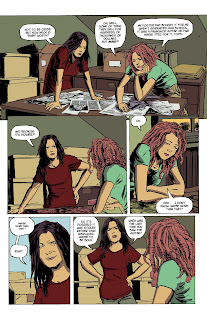


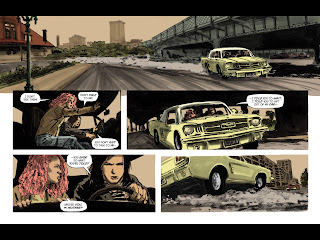
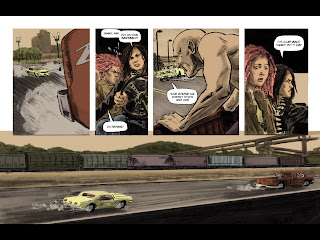







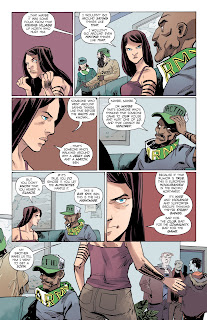







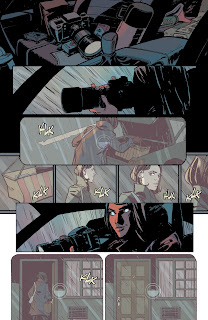

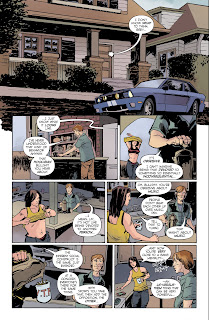



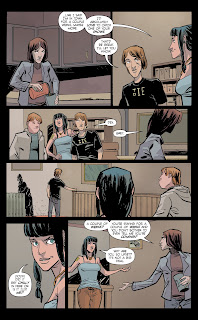




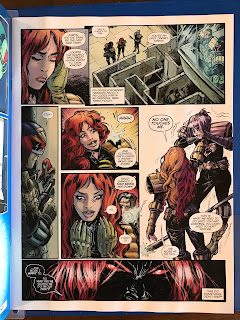
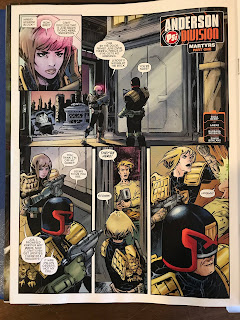









No comments:
Post a Comment